Business Report: Introduction to the Airline Industry and its Dynamics
VerifiedAdded on 2020/10/22
|7
|1412
|372
Report
AI Summary
This report offers a comprehensive introduction to the airline industry, delving into its key players, regulatory frameworks, and operational aspects. It examines major players like British Airways, Ryanair, and easyJet, while also exploring the influence of regulatory bodies such as the Civil Aviation Act 1982 and the Civil Aviation (Provision of Information to Passengers) Regulations 2006. The report further analyzes various factors that influence the industry's development, including political factors, competition, and external threats such as terrorism and disease outbreaks. It also highlights the inter-relationships between the commercial and operational areas of airlines, emphasizing the importance of coordination to enhance customer satisfaction and overall industry growth. The conclusion summarizes the key findings, emphasizing the need to consider regulatory frameworks, industry understanding, and the impact of various factors for the airline industry's effective development and success.
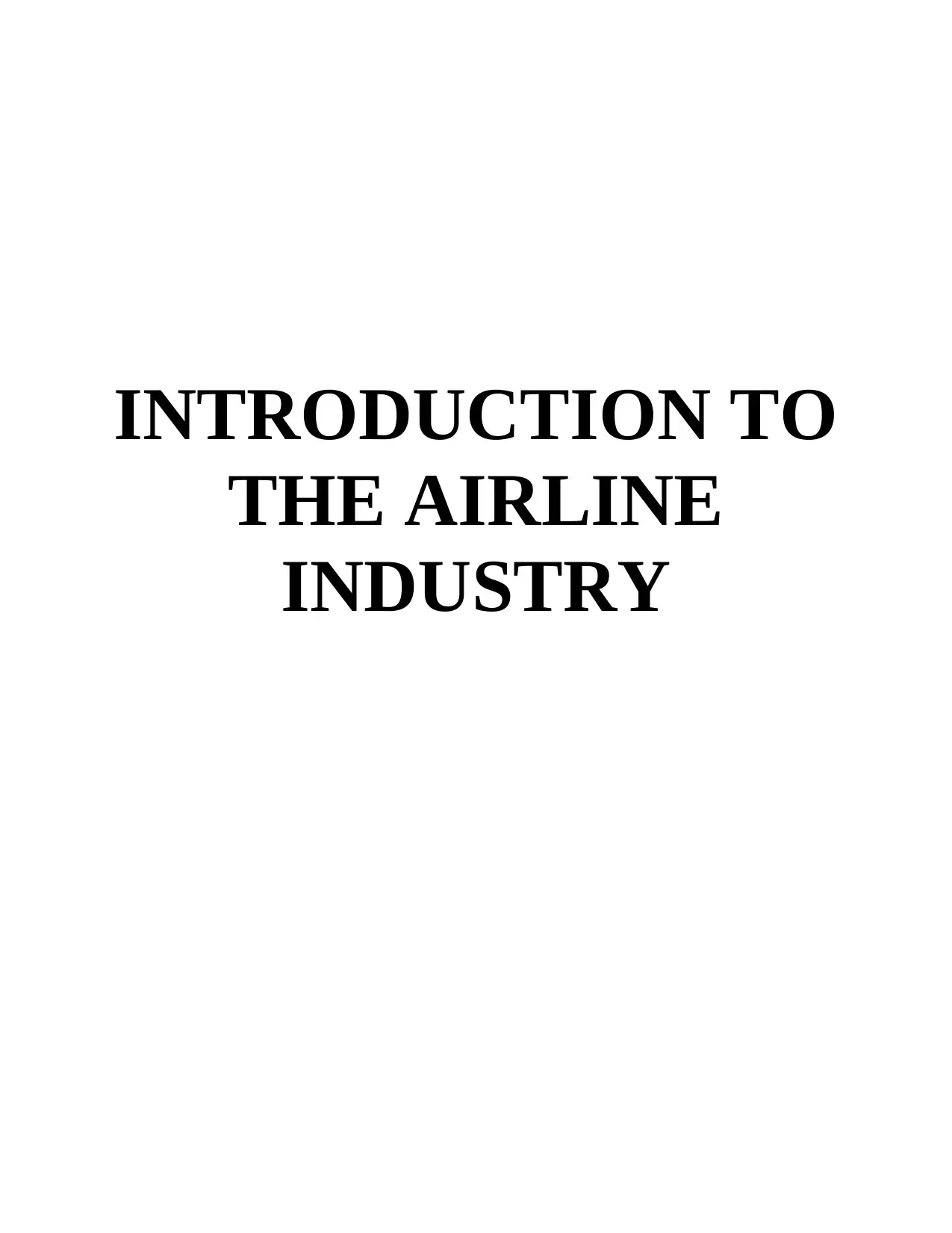
INTRODUCTION TO
THE AIRLINE
INDUSTRY
THE AIRLINE
INDUSTRY
Paraphrase This Document
Need a fresh take? Get an instant paraphrase of this document with our AI Paraphraser
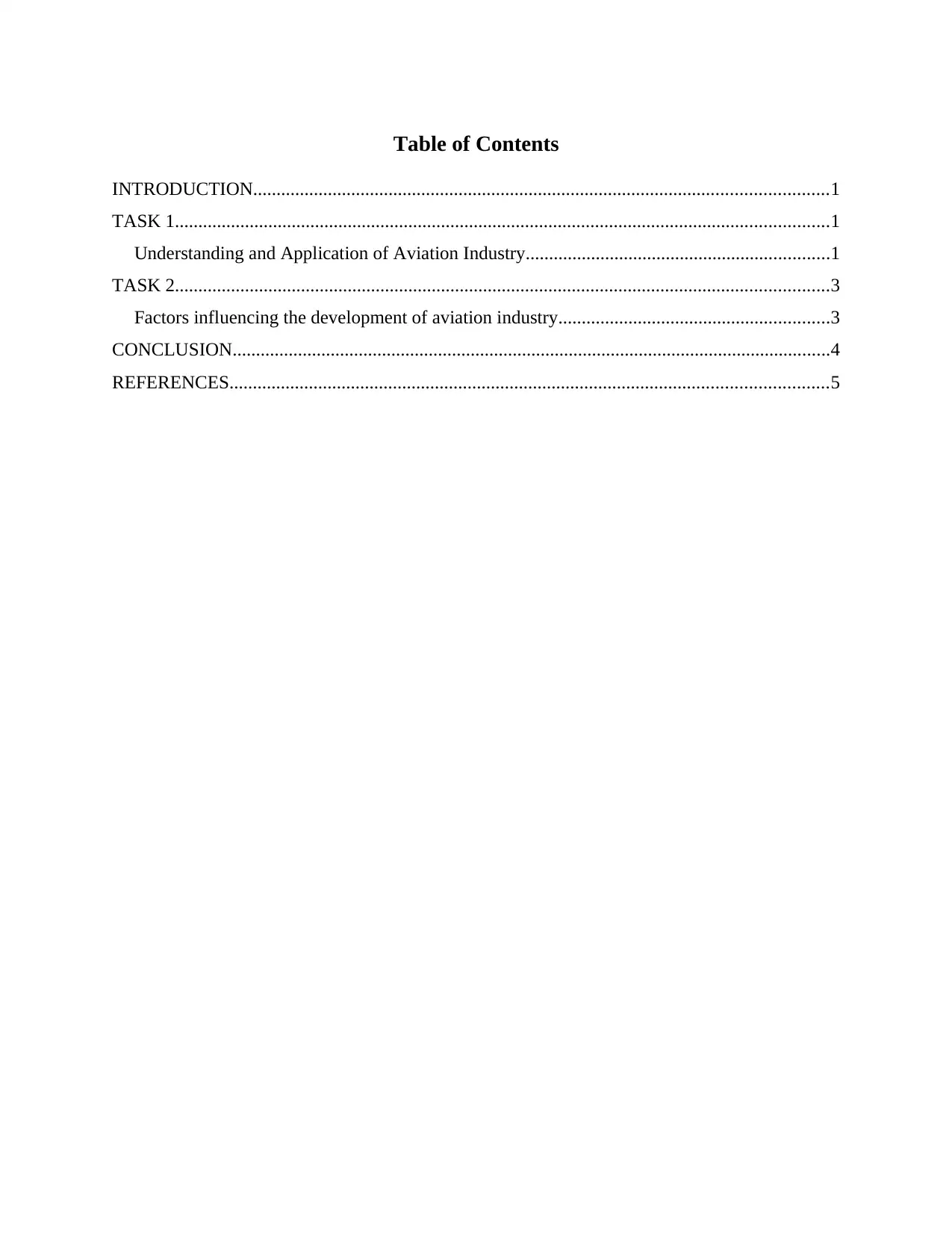
Table of Contents
INTRODUCTION...........................................................................................................................1
TASK 1............................................................................................................................................1
Understanding and Application of Aviation Industry.................................................................1
TASK 2............................................................................................................................................3
Factors influencing the development of aviation industry..........................................................3
CONCLUSION................................................................................................................................4
REFERENCES................................................................................................................................5
INTRODUCTION...........................................................................................................................1
TASK 1............................................................................................................................................1
Understanding and Application of Aviation Industry.................................................................1
TASK 2............................................................................................................................................3
Factors influencing the development of aviation industry..........................................................3
CONCLUSION................................................................................................................................4
REFERENCES................................................................................................................................5
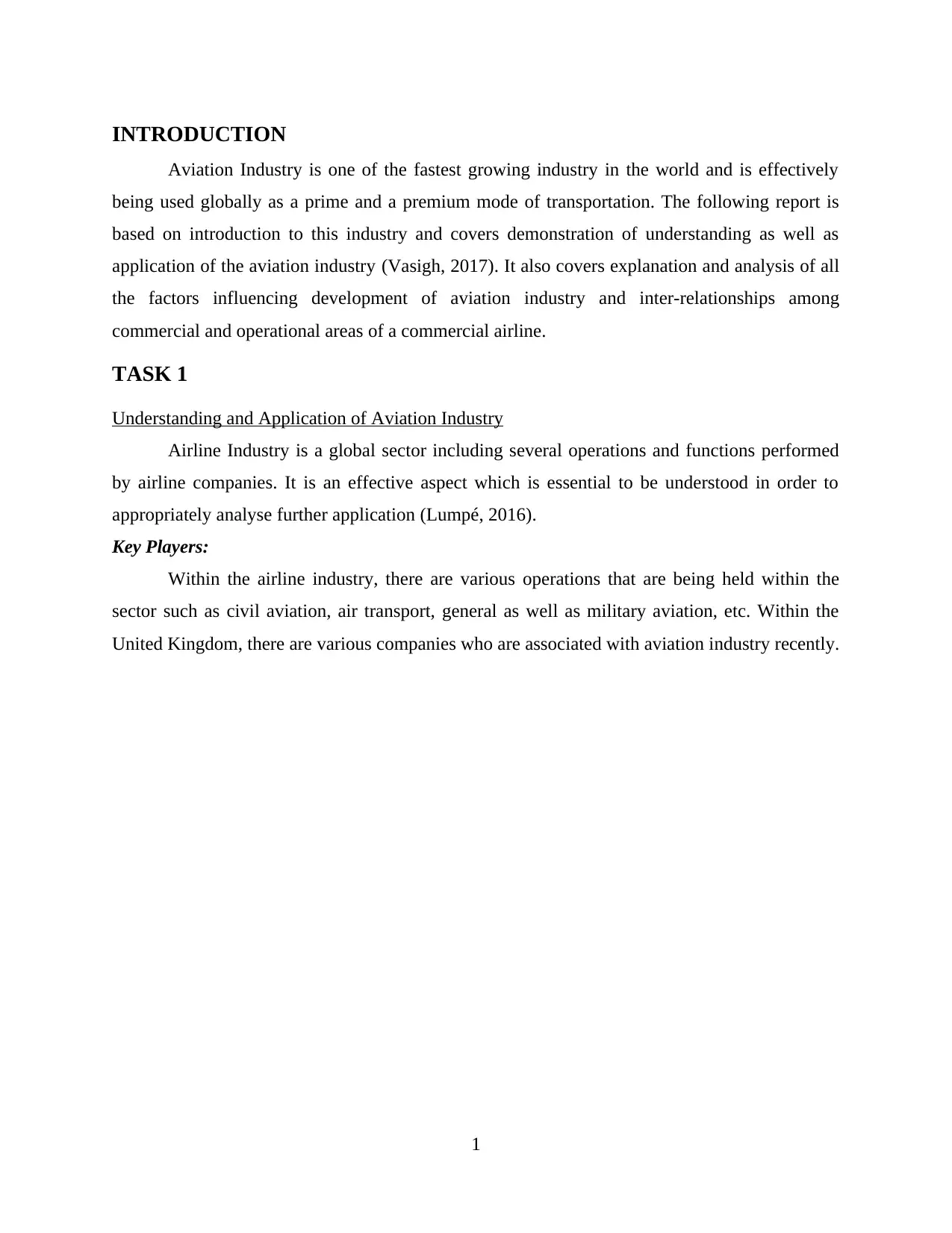
INTRODUCTION
Aviation Industry is one of the fastest growing industry in the world and is effectively
being used globally as a prime and a premium mode of transportation. The following report is
based on introduction to this industry and covers demonstration of understanding as well as
application of the aviation industry (Vasigh, 2017). It also covers explanation and analysis of all
the factors influencing development of aviation industry and inter-relationships among
commercial and operational areas of a commercial airline.
TASK 1
Understanding and Application of Aviation Industry
Airline Industry is a global sector including several operations and functions performed
by airline companies. It is an effective aspect which is essential to be understood in order to
appropriately analyse further application (Lumpé, 2016).
Key Players:
Within the airline industry, there are various operations that are being held within the
sector such as civil aviation, air transport, general as well as military aviation, etc. Within the
United Kingdom, there are various companies who are associated with aviation industry recently.
1
Aviation Industry is one of the fastest growing industry in the world and is effectively
being used globally as a prime and a premium mode of transportation. The following report is
based on introduction to this industry and covers demonstration of understanding as well as
application of the aviation industry (Vasigh, 2017). It also covers explanation and analysis of all
the factors influencing development of aviation industry and inter-relationships among
commercial and operational areas of a commercial airline.
TASK 1
Understanding and Application of Aviation Industry
Airline Industry is a global sector including several operations and functions performed
by airline companies. It is an effective aspect which is essential to be understood in order to
appropriately analyse further application (Lumpé, 2016).
Key Players:
Within the airline industry, there are various operations that are being held within the
sector such as civil aviation, air transport, general as well as military aviation, etc. Within the
United Kingdom, there are various companies who are associated with aviation industry recently.
1
⊘ This is a preview!⊘
Do you want full access?
Subscribe today to unlock all pages.

Trusted by 1+ million students worldwide
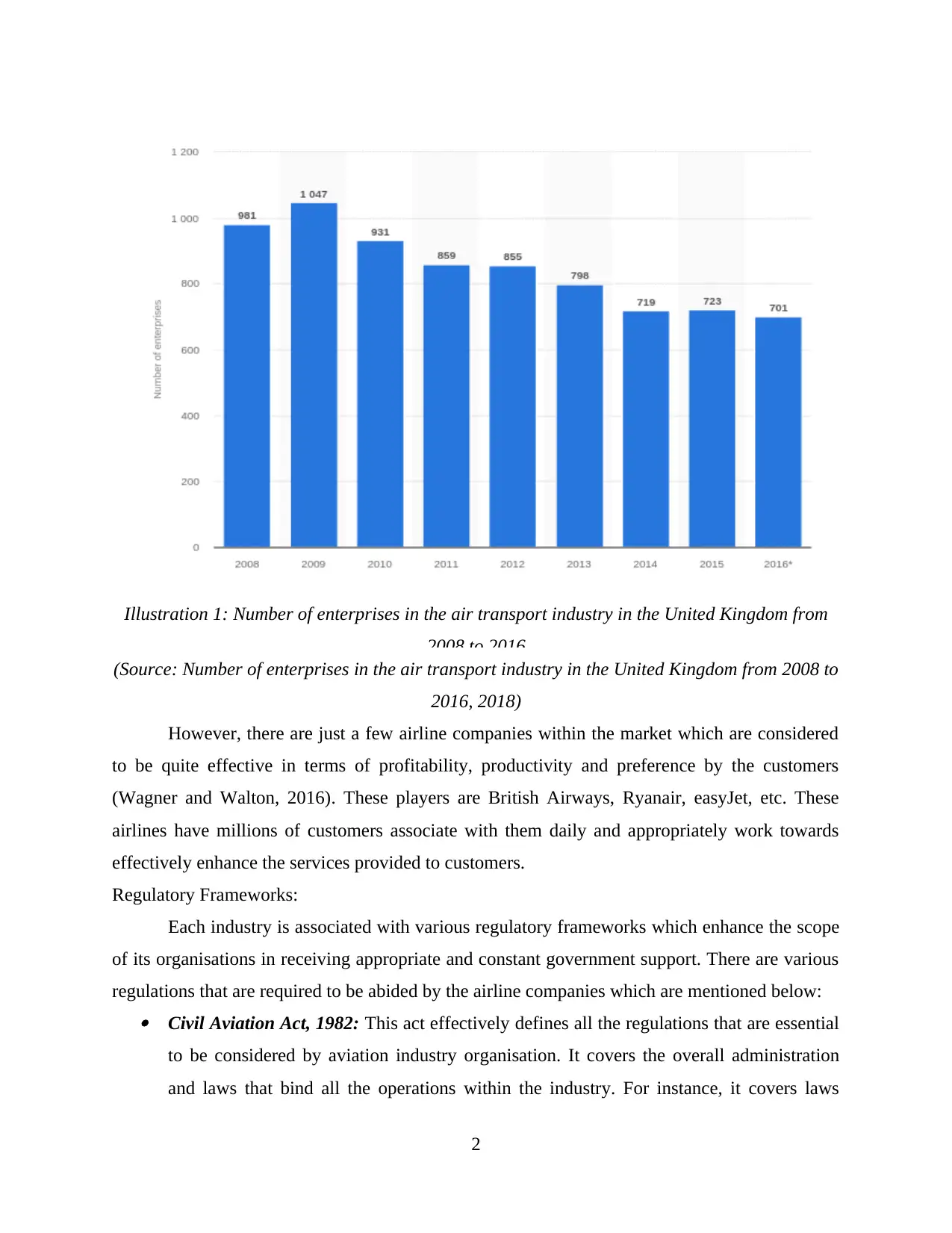
(Source: Number of enterprises in the air transport industry in the United Kingdom from 2008 to
2016, 2018)
However, there are just a few airline companies within the market which are considered
to be quite effective in terms of profitability, productivity and preference by the customers
(Wagner and Walton, 2016). These players are British Airways, Ryanair, easyJet, etc. These
airlines have millions of customers associate with them daily and appropriately work towards
effectively enhance the services provided to customers.
Regulatory Frameworks:
Each industry is associated with various regulatory frameworks which enhance the scope
of its organisations in receiving appropriate and constant government support. There are various
regulations that are required to be abided by the airline companies which are mentioned below: Civil Aviation Act, 1982: This act effectively defines all the regulations that are essential
to be considered by aviation industry organisation. It covers the overall administration
and laws that bind all the operations within the industry. For instance, it covers laws
2
Illustration 1: Number of enterprises in the air transport industry in the United Kingdom from
2008 to 2016
2016, 2018)
However, there are just a few airline companies within the market which are considered
to be quite effective in terms of profitability, productivity and preference by the customers
(Wagner and Walton, 2016). These players are British Airways, Ryanair, easyJet, etc. These
airlines have millions of customers associate with them daily and appropriately work towards
effectively enhance the services provided to customers.
Regulatory Frameworks:
Each industry is associated with various regulatory frameworks which enhance the scope
of its organisations in receiving appropriate and constant government support. There are various
regulations that are required to be abided by the airline companies which are mentioned below: Civil Aviation Act, 1982: This act effectively defines all the regulations that are essential
to be considered by aviation industry organisation. It covers the overall administration
and laws that bind all the operations within the industry. For instance, it covers laws
2
Illustration 1: Number of enterprises in the air transport industry in the United Kingdom from
2008 to 2016
Paraphrase This Document
Need a fresh take? Get an instant paraphrase of this document with our AI Paraphraser

regarding licenses of carriages, passenger safety, laws regarding aircraft nuisance, etc.
(Civil Aviation Act 1982, 2018.). Moreover, the act lays down accounts for penalty and
serious punishment as well. Civil Aviation (Provision of Information to Passengers) Regulations 2006: Under this
act, aviation organisation are required to provide their customers with their right to be
informed. They must give appropriate, authentic as well as effective information to their
passengers regarding their flight schedules, condition of aircraft, pricing rates, etc.
Factors Influencing Industry's Development
There are various factors which are associated with development of aviation industry
such as political factors, competition as well as terrorism, war and disease outbreaks. All these
factors influence and impact the aviation business organisation and are essential for these
companies to realise in order to conduct their operations effectively.
TASK 2
Factors influencing the development of aviation industry
There are various factors which influences the development of aviation industry in
getting the desired growth and profit. These factors can affect the airlines such as British
Airways in accomplishing their goals and objectives. Some of these factors are discussed below:
Political factors: These can affect the development of British airlines as the policies of
the government regulates and control the prices of the services provided by the aviation firms.
Also the policies associated with tax, international trade etc. can effect the productivity of the
firms due to the transporting the passengers from one country to another. Firms needs to
determine such laws and policies so that the affect can be reduced or minimised.
Competition: Due to the growth of aviation industry, competition has also increased as
many major players are giving tough competition to the British airlines. The Deregulation Act of
1978 has all the limitations in the fare prices, airline routes etc. due to which several commercial
airline companies started the business in the industry and pushing the competition more higher
(İLARSLAN, VURUR and BIYIKLI, 2014). Also low fares is the major problem for the airline
industry as it increases the operational costs.
War, Terrorism, disease outbreaks: These also effects the industry as these can impact
the travelling behaviour of the passengers due to the danger involved. This will leads to the
3
(Civil Aviation Act 1982, 2018.). Moreover, the act lays down accounts for penalty and
serious punishment as well. Civil Aviation (Provision of Information to Passengers) Regulations 2006: Under this
act, aviation organisation are required to provide their customers with their right to be
informed. They must give appropriate, authentic as well as effective information to their
passengers regarding their flight schedules, condition of aircraft, pricing rates, etc.
Factors Influencing Industry's Development
There are various factors which are associated with development of aviation industry
such as political factors, competition as well as terrorism, war and disease outbreaks. All these
factors influence and impact the aviation business organisation and are essential for these
companies to realise in order to conduct their operations effectively.
TASK 2
Factors influencing the development of aviation industry
There are various factors which influences the development of aviation industry in
getting the desired growth and profit. These factors can affect the airlines such as British
Airways in accomplishing their goals and objectives. Some of these factors are discussed below:
Political factors: These can affect the development of British airlines as the policies of
the government regulates and control the prices of the services provided by the aviation firms.
Also the policies associated with tax, international trade etc. can effect the productivity of the
firms due to the transporting the passengers from one country to another. Firms needs to
determine such laws and policies so that the affect can be reduced or minimised.
Competition: Due to the growth of aviation industry, competition has also increased as
many major players are giving tough competition to the British airlines. The Deregulation Act of
1978 has all the limitations in the fare prices, airline routes etc. due to which several commercial
airline companies started the business in the industry and pushing the competition more higher
(İLARSLAN, VURUR and BIYIKLI, 2014). Also low fares is the major problem for the airline
industry as it increases the operational costs.
War, Terrorism, disease outbreaks: These also effects the industry as these can impact
the travelling behaviour of the passengers due to the danger involved. This will leads to the
3
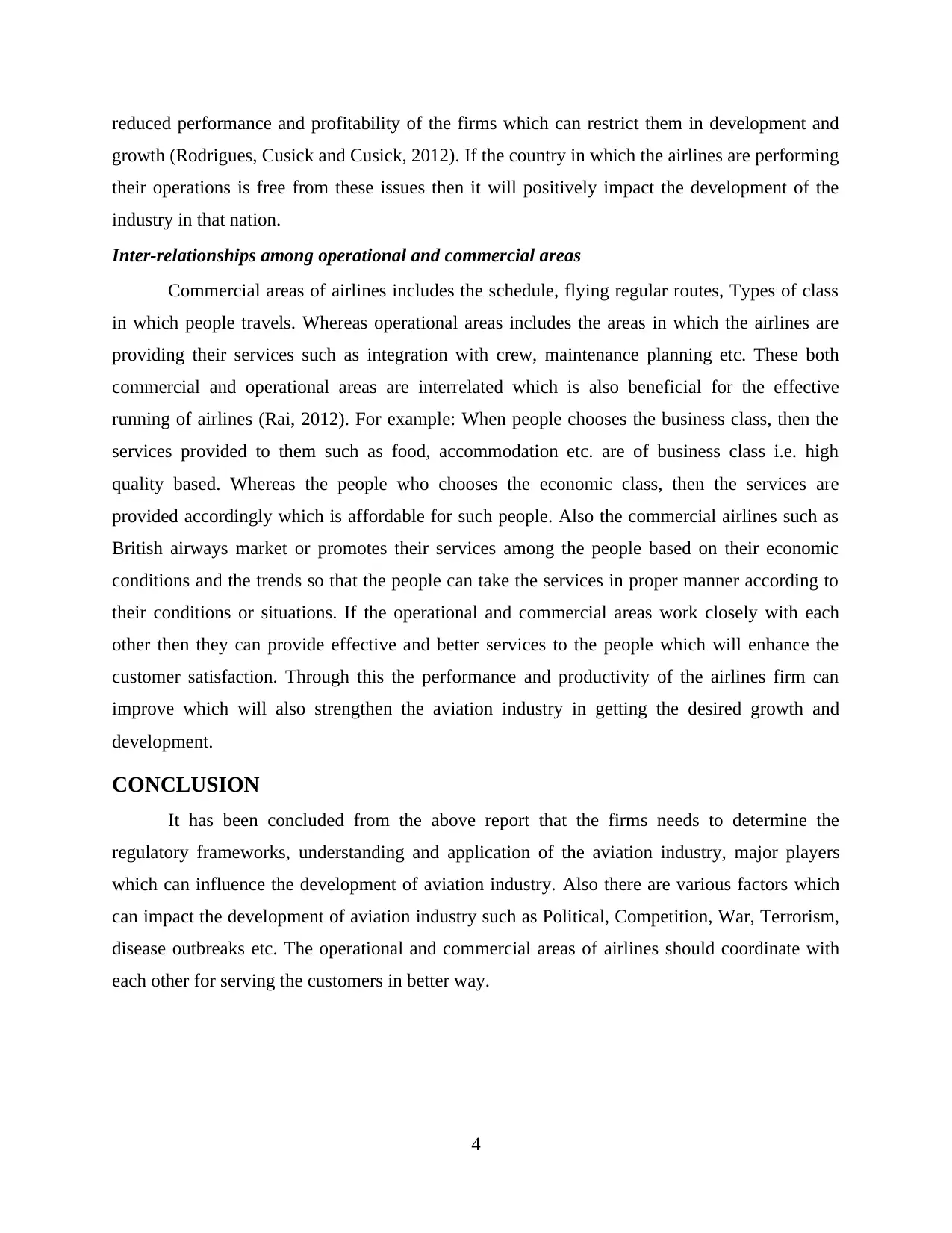
reduced performance and profitability of the firms which can restrict them in development and
growth (Rodrigues, Cusick and Cusick, 2012). If the country in which the airlines are performing
their operations is free from these issues then it will positively impact the development of the
industry in that nation.
Inter-relationships among operational and commercial areas
Commercial areas of airlines includes the schedule, flying regular routes, Types of class
in which people travels. Whereas operational areas includes the areas in which the airlines are
providing their services such as integration with crew, maintenance planning etc. These both
commercial and operational areas are interrelated which is also beneficial for the effective
running of airlines (Rai, 2012). For example: When people chooses the business class, then the
services provided to them such as food, accommodation etc. are of business class i.e. high
quality based. Whereas the people who chooses the economic class, then the services are
provided accordingly which is affordable for such people. Also the commercial airlines such as
British airways market or promotes their services among the people based on their economic
conditions and the trends so that the people can take the services in proper manner according to
their conditions or situations. If the operational and commercial areas work closely with each
other then they can provide effective and better services to the people which will enhance the
customer satisfaction. Through this the performance and productivity of the airlines firm can
improve which will also strengthen the aviation industry in getting the desired growth and
development.
CONCLUSION
It has been concluded from the above report that the firms needs to determine the
regulatory frameworks, understanding and application of the aviation industry, major players
which can influence the development of aviation industry. Also there are various factors which
can impact the development of aviation industry such as Political, Competition, War, Terrorism,
disease outbreaks etc. The operational and commercial areas of airlines should coordinate with
each other for serving the customers in better way.
4
growth (Rodrigues, Cusick and Cusick, 2012). If the country in which the airlines are performing
their operations is free from these issues then it will positively impact the development of the
industry in that nation.
Inter-relationships among operational and commercial areas
Commercial areas of airlines includes the schedule, flying regular routes, Types of class
in which people travels. Whereas operational areas includes the areas in which the airlines are
providing their services such as integration with crew, maintenance planning etc. These both
commercial and operational areas are interrelated which is also beneficial for the effective
running of airlines (Rai, 2012). For example: When people chooses the business class, then the
services provided to them such as food, accommodation etc. are of business class i.e. high
quality based. Whereas the people who chooses the economic class, then the services are
provided accordingly which is affordable for such people. Also the commercial airlines such as
British airways market or promotes their services among the people based on their economic
conditions and the trends so that the people can take the services in proper manner according to
their conditions or situations. If the operational and commercial areas work closely with each
other then they can provide effective and better services to the people which will enhance the
customer satisfaction. Through this the performance and productivity of the airlines firm can
improve which will also strengthen the aviation industry in getting the desired growth and
development.
CONCLUSION
It has been concluded from the above report that the firms needs to determine the
regulatory frameworks, understanding and application of the aviation industry, major players
which can influence the development of aviation industry. Also there are various factors which
can impact the development of aviation industry such as Political, Competition, War, Terrorism,
disease outbreaks etc. The operational and commercial areas of airlines should coordinate with
each other for serving the customers in better way.
4
⊘ This is a preview!⊘
Do you want full access?
Subscribe today to unlock all pages.

Trusted by 1+ million students worldwide
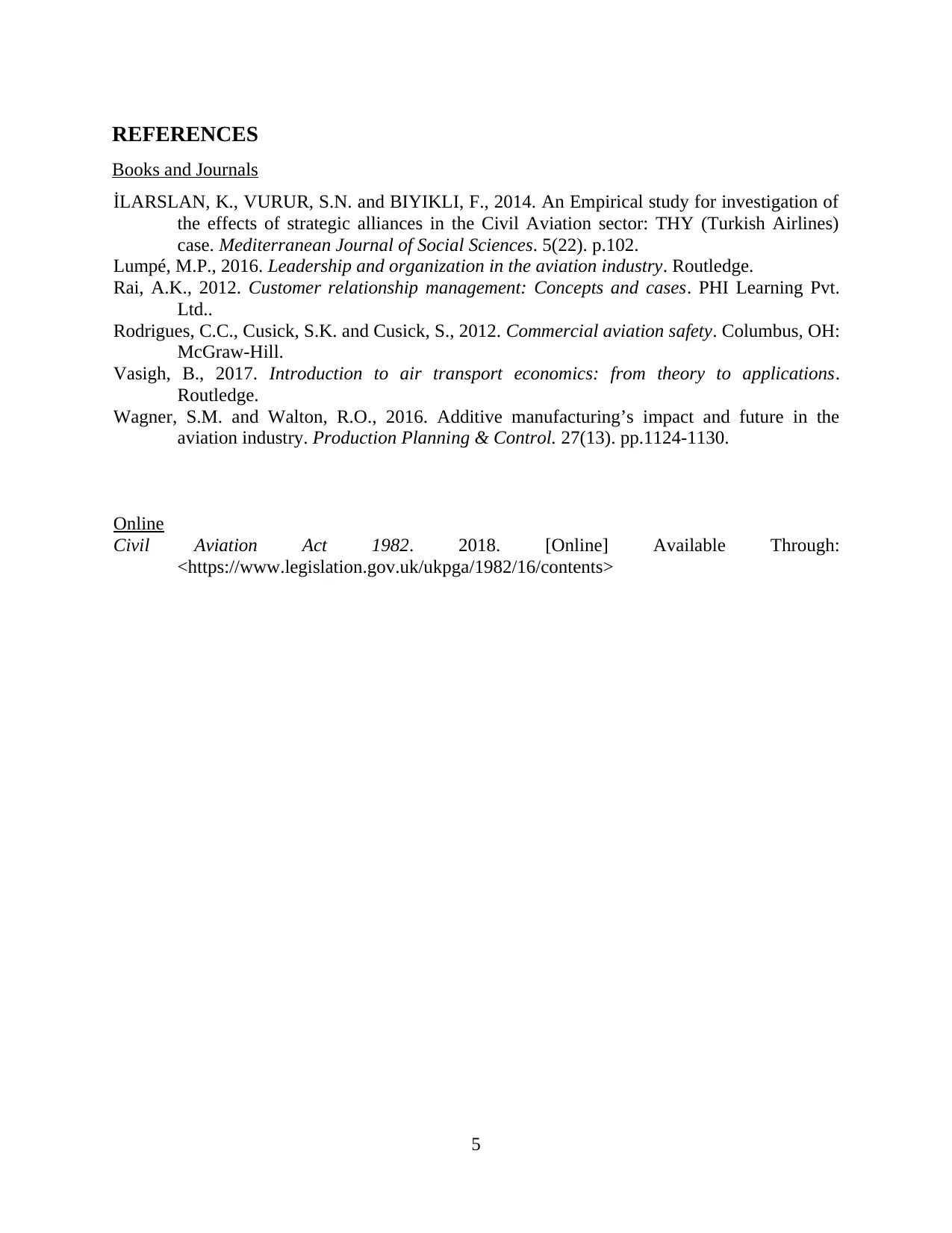
REFERENCES
Books and Journals
İLARSLAN, K., VURUR, S.N. and BIYIKLI, F., 2014. An Empirical study for investigation of
the effects of strategic alliances in the Civil Aviation sector: THY (Turkish Airlines)
case. Mediterranean Journal of Social Sciences. 5(22). p.102.
Lumpé, M.P., 2016. Leadership and organization in the aviation industry. Routledge.
Rai, A.K., 2012. Customer relationship management: Concepts and cases. PHI Learning Pvt.
Ltd..
Rodrigues, C.C., Cusick, S.K. and Cusick, S., 2012. Commercial aviation safety. Columbus, OH:
McGraw-Hill.
Vasigh, B., 2017. Introduction to air transport economics: from theory to applications.
Routledge.
Wagner, S.M. and Walton, R.O., 2016. Additive manufacturing’s impact and future in the
aviation industry. Production Planning & Control. 27(13). pp.1124-1130.
Online
Civil Aviation Act 1982. 2018. [Online] Available Through:
<https://www.legislation.gov.uk/ukpga/1982/16/contents>
5
Books and Journals
İLARSLAN, K., VURUR, S.N. and BIYIKLI, F., 2014. An Empirical study for investigation of
the effects of strategic alliances in the Civil Aviation sector: THY (Turkish Airlines)
case. Mediterranean Journal of Social Sciences. 5(22). p.102.
Lumpé, M.P., 2016. Leadership and organization in the aviation industry. Routledge.
Rai, A.K., 2012. Customer relationship management: Concepts and cases. PHI Learning Pvt.
Ltd..
Rodrigues, C.C., Cusick, S.K. and Cusick, S., 2012. Commercial aviation safety. Columbus, OH:
McGraw-Hill.
Vasigh, B., 2017. Introduction to air transport economics: from theory to applications.
Routledge.
Wagner, S.M. and Walton, R.O., 2016. Additive manufacturing’s impact and future in the
aviation industry. Production Planning & Control. 27(13). pp.1124-1130.
Online
Civil Aviation Act 1982. 2018. [Online] Available Through:
<https://www.legislation.gov.uk/ukpga/1982/16/contents>
5
1 out of 7
Related Documents
Your All-in-One AI-Powered Toolkit for Academic Success.
+13062052269
info@desklib.com
Available 24*7 on WhatsApp / Email
![[object Object]](/_next/static/media/star-bottom.7253800d.svg)
Unlock your academic potential
© 2024 | Zucol Services PVT LTD | All rights reserved.





